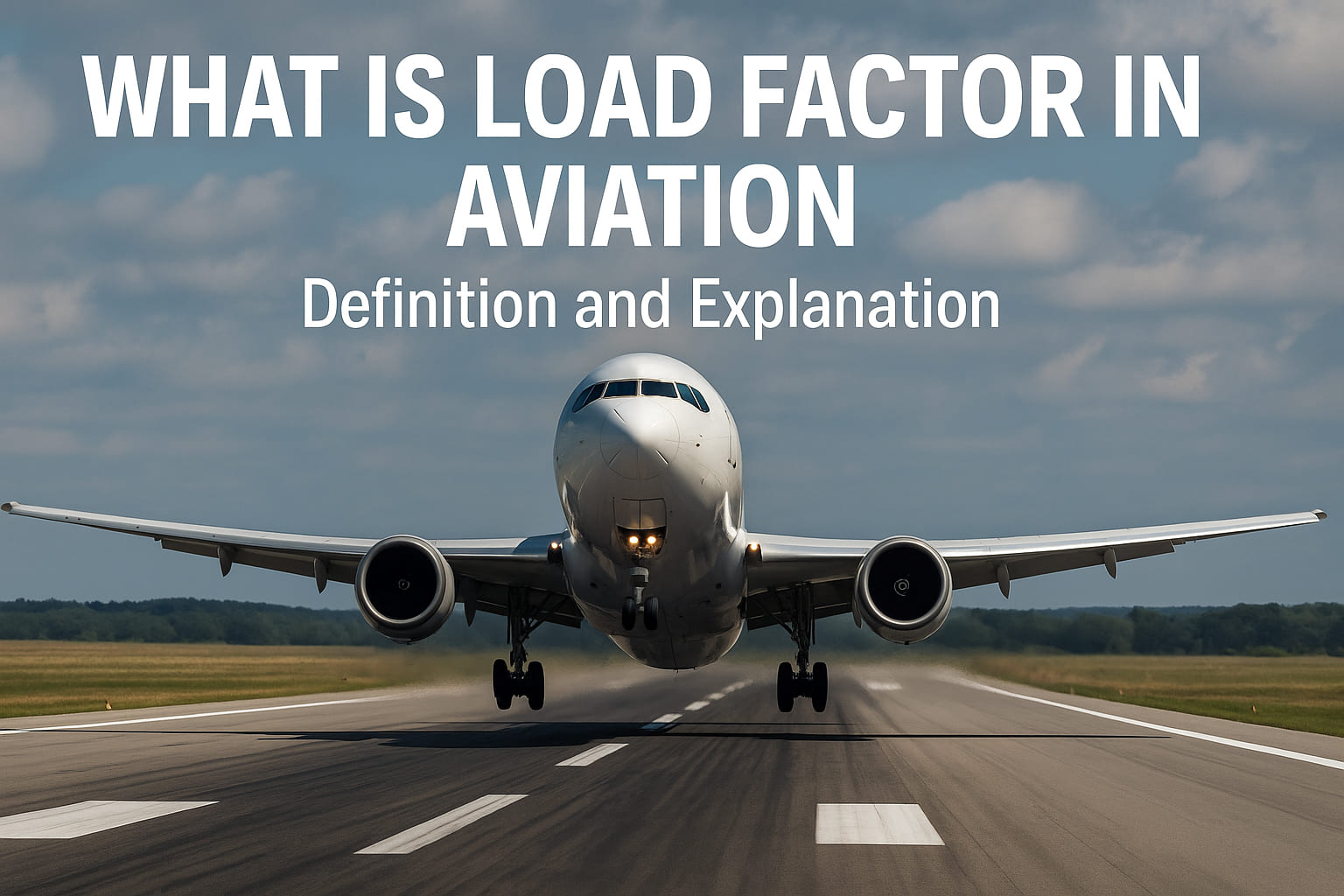The term ‘load factor’ has two distinct meanings in aviation: one for pilots in the cockpit and the other for managers in the boardroom. It measures both the aerodynamic stress on an airframe in Gs and an airline’s commercial efficiency. Understanding what is load factor in aviation in both contexts is essential for grasping its full impact on flight safety and profitability.
👉 Check out the offer: aircraft engine stand for lease 👈
Understanding Load Factor — Definition and Importance
In aviation, the term ‘load factor’ has two distinct but equally important meanings. For pilots and engineers, it’s a critical measure of aerodynamic stress on an aircraft’s structure.
The primary aerodynamic definition of load factor is the ratio of the total lift an aircraft’s wings produce to its total weight. This ratio is expressed in Gs, where one ‘G’ represents the force of gravity we experience on Earth. It’s a direct measure of the stress the airframe is under. A load factor of 2 Gs, for instance, means the aircraft and its occupants feel a force equal to twice their normal weight.
On the commercial side, load factor is the percentage of an airline’s available capacity in use. This metric measures how full a flight is with paying passengers or cargo. For example, if a 100-seat aircraft carries 85 passengers, its load factor is 85%. This figure directly reflects an airline’s ability to fill its planes and generate revenue, making it a vital indicator of financial health.
Load Factor in Level Flight vs. Banking
To understand how load factor changes, consider the simplest scenario: straight-and-level, unaccelerated flight. In this state, the lift generated by the wings perfectly balances the aircraft’s total weight. Since load factor is the ratio of lift to weight (Lift ÷ Weight), the value is exactly 1. This is known as flying at 1 G—the familiar force of gravity we experience daily.
This changes when an aircraft banks into a turn. As the wings tilt, the lift they generate tilts with them. Consequently, only a portion of the lift counteracts gravity, while the rest pulls the aircraft horizontally through the turn. To maintain altitude, the pilot must increase total lift until its vertical component again equals the aircraft’s weight, which in turn raises the load factor above 1 G.
The steeper the bank, the higher the load factor. A gentle 30-degree bank, for instance, increases it to about 1.2 G, making everyone and everything on board feel 20% heavier. In a steep 60-degree bank, it jumps to 2 Gs. This exponential increase places significant stress on the airframe, which is why pilots must operate within the specific load factor limits designed for their aircraft.
Calculating Load Factor in Aviation Operations
From a pilot’s perspective, the aerodynamic load factor is determined by a simple physics formula:
Load Factor (N) = Lift (L) / Weight (W)
For airline management, the commercial metric—Passenger Load Factor (PLF)—measures financial efficiency and is calculated as follows:
Load Factor (%) = (Revenue Passenger Miles / Available Seat Miles) × 100
Here, ‘Revenue Passenger Miles‘ (RPMs) represent the total miles flown by paying passengers, while ‘Available Seat Miles‘ (ASM’s) represent the total seating capacity multiplied by the miles flown. For example, if a 150-seat aircraft flies a 1,000-mile route with 120 passengers, its load factor is 80%.
Seasonal Variations in Load Factor
An airline’s commercial load factor is rarely static; it varies seasonally. Driven by holidays, school breaks, and seasonal weather, passenger demand fluctuates naturally throughout the year. During peak travel periods, such as summer vacation or major holidays, demand surges, and airlines often achieve their highest load factors.
Conversely, the industry also has its quieter, off-peak months. In periods like late autumn or just after the New Year, passenger numbers decline, and load factors naturally drop. This is a predictable part of the annual business cycle that airlines must manage.
These seasonal variations are central to airline operational planning. To maximize year-round revenue, carriers adjust schedules, often reducing flight frequencies on certain routes during the low season.
Load Factor Limits and Safety Considerations
Every aircraft is engineered with specific structural tolerances, and its load factor limits define the safe operational envelope. Expressed in Gs, these limits represent the maximum positive and negative forces an airframe can withstand without risking structural damage.
These structural boundaries vary significantly with the aircraft’s intended purpose. A ‘normal’ category airplane, like a typical trainer, is generally certified for a positive load factor of +3.8 G and a negative limit of -1.52 G. In contrast, an**’acrobatic’ category** aircraft, designed for high-stress maneuvers, is certified to withstand far greater forces—often +6 G or more. This superior strength allows aerobatic planes to perform sharp turns and loops that would dangerously overstress a standard aircraft.
Exceeding certified load factor limits poses a serious safety risk. Pushing an aircraft beyond its boundaries overstresses the airframe, which can lead to permanent deformation or even catastrophic structural failure. Pilots are therefore rigorously trained to manage maneuvers like steep turns, turbulence recovery, and pull-ups. Their goal is to keep G-forces well within the prescribed safe range, a discipline fundamental to maintaining the aircraft’s structural integrity.
Load Factor and Aircraft Design
Load factor is far more than just an operational limit; it is a cornerstone of aircraft design.
The influence of load factor is evident in the physical construction of different aircraft. For example, the wings of an aerobatic aircraft are engineered with far more robust internal structures and stronger materials than a normal category plane, a direct consequence of its higher certified G-limits. These design choices ensure the aircraft remains safe and performs reliably across a wide range of flight conditions, from a gentle turn in a passenger plane to a high-G loop in a competition aircraft. Load factor dictates the crucial balance between performance, weight, and structural integrity between performance, weight, and structural integrity.
Impact of Load Factor on Operational Efficiency
A higher load factor directly improves financial health. A flight’s significant fixed costs—fuel, crew salaries, maintenance, and airport fees—remain largely the same whether the plane is half-empty or completely full.
Beyond individual flights, airlines use load factor data to make strategic decisions about schedules, routes, and fleet choices. A route with a consistently high load factor, for example, may warrant more frequent flights or a larger aircraft. Conversely, a route with persistently low numbers might see its service reduced or be assigned a smaller, more economical plane to better match capacity with demand. This data-driven approach is key to maximizing resource utilization and maintaining a competitive edge.
Load Factor and Competitive Advantage
A high load factor is more than a metric; it’s a powerful competitive weapon in the airline industry. Maximizing revenue from every available seat significantly improves its profitability and financial stability. This efficiency is self-reinforcing: higher revenue and lower costs per passenger strengthen the airline’s financial position, enabling it to invest in better services, expand its network, or weather economic downturns more effectively than its rivals.
This financial strength provides pricing power. With lower unit costs, an airline with consistently high load factors can offer more competitive fares to attract price-sensitive travelers. This strategy not only maintains high occupancy rates but also puts immense pressure on less efficient competitors, who may struggle to match such prices without operating at a loss.
Airlines that master capacity utilization outperform their rivals in both operational efficiency and financial performance. Consistently high load factors signal superior fleet management and an accurate grasp of market demand. This operational excellence leads to stronger financial statements and builds a reputation for success, making the airline a preferred choice for passengers and investors alike.

